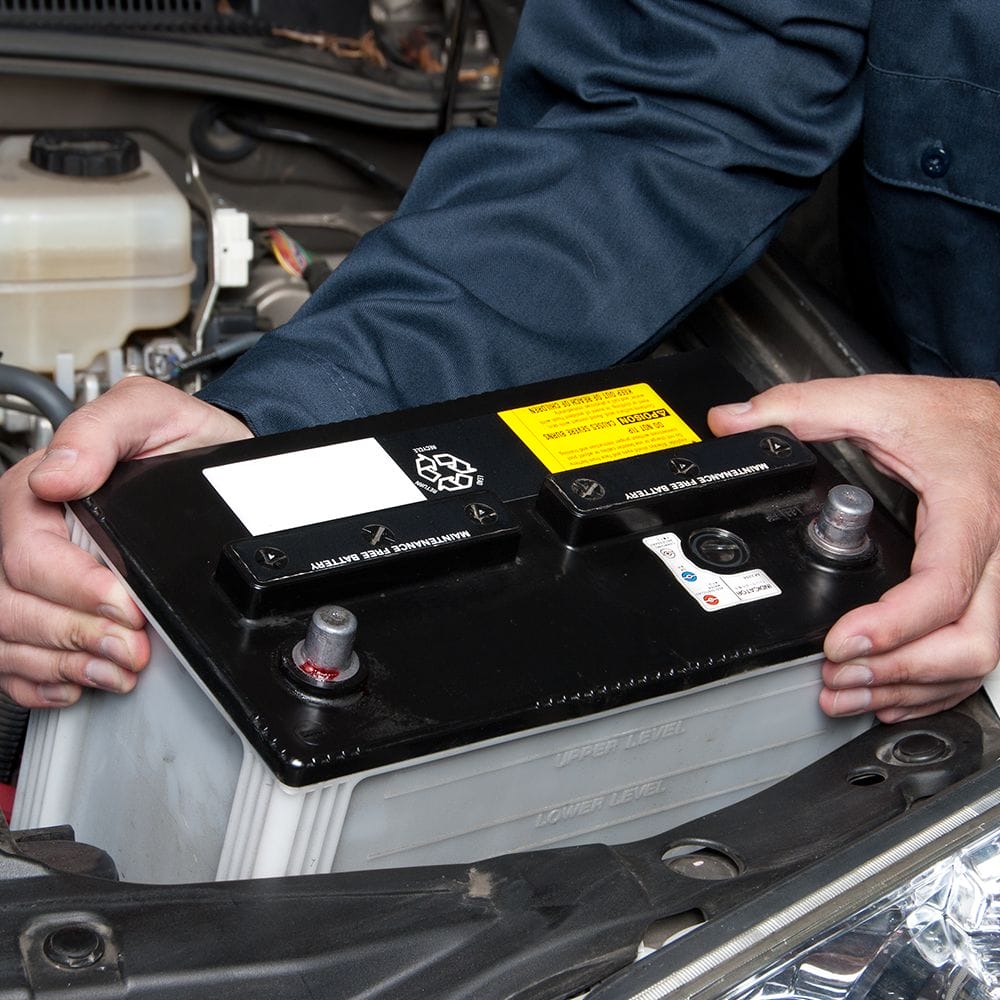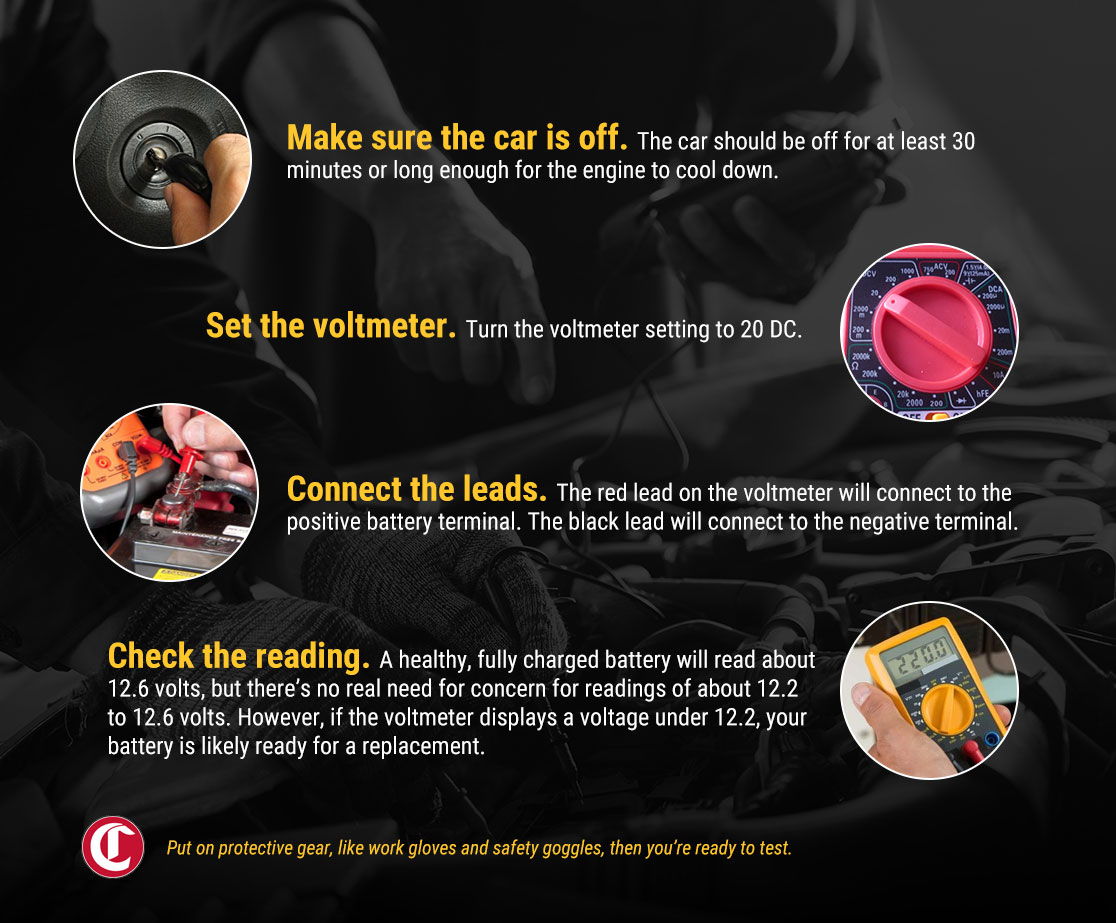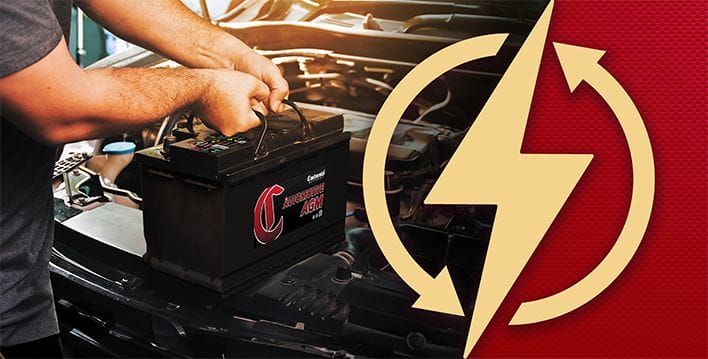
You’ve had to jumpstart your vehicle nearly every day this week just to get to work on time, and although you suspect it’s time for a new battery, the local auto shop is booked for weeks. As such, you’re determined to learn how to replace an automotive battery to get back on the road.
Swapping out a vehicle battery is DIY-friendly, but it requires some precautions and extra care to avoid causing any damage to your vehicle. With this step-by-step guide, you’ll be changing a car battery like a pro.
Test Your Battery to Determine If You Need a Replacement
There are many signs that your battery is dying, from its age to its performance. Batteries nearing five years of age may be ready for a replacement, and a dying battery may require frequent jumpstarts just to get you from home to work and back.
To be sure it’s time for a new battery, you can test the car battery with a voltmeter. Put on protective gear, like work gloves and safety goggles, then you’re ready to test.

Prep by Buying the Right Battery
Once you’ve tested the battery and determined it’s time to replace it, you’ll want to make sure to get a battery that is compatible with your vehicle as well as your performance needs. First, consult with your vehicle manual to determine what size battering and the amperage and CCA you need.
If you purchase a car battery that has a larger size or output, it may not fit into the holding tray at all. Even if it does fit, it may produce too much power for your vehicle, and this can damage the electrical components of the vehicle.
If the battery is too small, it won’t sit securely in the holding tray, and this brings a risk of battery leaks. If the battery doesn’t provide the minimum recommended Cold Cranking Amps (CCA), it may not be able to power up your vehicle.
Another consideration is the battery type. Electric vehicles or plug-in hybrid vehicles typically use lithium-ion batteries. Many other vehicles use flooded lead-acid batteries or more advanced batteries, such as sealed lead acid (SLA) or absorbent glass mat (AGM) batteries.
Flooded lead-acid batteries are pretty standard and can typically be replaced with advanced batteries. If your vehicle came with a more advanced battery, though, you should replace it with the same type rather than trying to replace it with a conventional flooded lead-acid battery. That’s because some vehicles, particularly those with high-tech features like start-stop functionality, require more power than advanced batteries can supply.
How to Replace a Car Battery in 12 Steps
Replacing an automotive battery is a fairly straightforward process, and you don’t need a background in auto mechanics to do it yourself. You’ll need a few tools and supplies, many of which you may already have at home or in your garage.
Tools and Supplies:
- Work gloves
- Safety goggles
- Socket wrench
- Terminal puller (optional)
- Baking soda
- Water
- Wire brush
- Cloths
- Anti-corrosion spray or gel
- New battery
- Set up a safe workspace. Make sure the car is parked, with the emergency brake on, and turned off. Let the vehicle cool down for at least 30 minutes if you’ve turned it on recently. Open the garage door if you are working in the garage to let any potential fumes escape safely. If your vehicle is parked on a steeply sloped road or driveway, nudge a wood block behind the tires for added safety.
* Before you locate and disconnect the battery, you may want to use a memory saver to preserve your vehicle’s electrical settings, such as programmed radio stations or seat settings. Learn more about using a memory saver below.
- Locate the battery. If you didn’t test the battery beforehand, you may not be aware of your battery’s location. Turn to the vehicle manual to locate the battery. While many drivers expect the battery to be under the hood, that’s not always the case. It could also be under the trunk or floorboard.
- ID the positive and negative terminals. Mixing up your battery terminals can cause an electrical surge that will do serious damage to your vehicle and battery. It could even cause the battery to explode, so it’s important to take a few moments to determine where the positive and negative terminals are located. The positive terminal is marked with a “+” symbol. The negative terminal will be marked by a “-” symbol.
- Disconnect the negative terminal first. Always disconnect the negative terminal first, as this terminal is grounded and won’t produce an electrical short or sparks during the disconnect. If it doesn’t disconnect from the battery easily, you can buy a terminal puller for about $20.
- Disconnect the positive terminal. Next, repeat the process with the positive terminal. When removing this terminal, make sure the wrench doesn’t come into contact with any other metal parts.
- Remove the old battery from the car. After disconnecting the negative and positive terminals from the batteries, you’ll need to remove the clamp or clamps located around the outside of the battery. Use a wrench to loosen the nuts of the clamp or clamps. With the clamps removed and set aside safely, you should be able to lift the old battery out of its holding tray. Just keep in mind the battery is heavier than it looks, up to 60 pounds.
- Clean the battery terminals. Before you install the new battery, you’ll want to clean the terminals, as corrosion can shorten the lifespan of your battery. Make a cleaning paste of baking soda and water, then use a wire brush with the cleaning paste to clean the terminals. Use a cloth to thoroughly and completely dry the terminals. Finish by applying an anti-corrosion spray or gel on the terminals.
- Position the battery. Place the new battery into the holding tray, with the positive node on the battery near the positive terminal and cable of the car and the negative side of the battery near the negative terminal and cable of the car.
- Reattach the clamps. Use a wrench and the clamp(s) you set aside in step six to secure the battery into its place in the tray. With the battery in place, you can now remove the red and black plastic covers on the positive and negative posts on the battery.
- Reconnect the positive terminal first. For the safety of yourself and the vehicle, make sure to reconnect the positive terminal first. Attach the red, positive terminal to the positive node on the battery, tightening it with the wrench.
- Reconnect the negative terminal. Next, repeat the process and connect the car’s black negative terminal to the battery’s negative post.
- Confirm the battery is secure. Try to move or wiggle the battery around. It should remain still; if it moves, double-check the clamp(s) and tighten them up as needed.
Now, the new automotive battery should be ready to go. Make sure to close the car hood or replace the trunk covering or floorboard. Take any tools and supplies back to the garage, place your old car battery in a thick plastic bag and keep it upright so you can transport it safely to a recycling center as soon as possible.
Using a Memory Saver for High-Tech Vehicles
Modern vehicles have all sorts of bells and whistles to make driving more comfortable and convenient. For instance, your car might have driver settings that automatically adjust the seat position and mirrors for specified drivers, or you may have programmed your favorite radio stations. When you change the battery, you could lose these presets, although your vehicle can relearn them, or you can simply reprogram them.
If you want to save them, you can buy a memory-saver device, which costs about $30 to $130, depending on the model.
Before you begin the process of disconnecting the old battery, connect the memory saver to a power supply. The power supply may be a 12-volt battery, sometimes included with the memory saver or a jump box. Then, connect the memory-saver device to the DLC or diagnostic link connector, typically located beneath the steering wheel.
Disconnect the battery, but be especially careful with the positive terminal and cable since it is now live with the memory saver plugged in. Use a cloth and electrical tape to cover the cable while you work. Install the new battery; then, you can unplug the memory saver.
How Long Does It Take to Replace a Car Battery?
Replacing a car battery takes about 30 minutes to an hour, depending on your vehicle. If the battery is under the hood and easy to access, you can usually get this job done quickly.
But when the battery is harder to access, with the unit under the truck, below the floorboards, or tucked away somewhere, like in the wheel well or toward the back of the car, it can take over an hour. You’ll need to spend more time locating the battery and getting into the hard-to-reach spaces to safely remove the terminals and replace the battery.
How Often Does a Car Battery Need to Be Replaced?
Most car batteries need to be replaced every three to five years. More advanced batteries, such as AGM batteries, may last longer, up to six years. Electric vehicles, which use lithium-ion batteries, may only need a new battery every ten years or so.
Call In the Pros If You Need Help
Unfortunately, there are many opportunities for electrical damage to occur when replacing a vehicle battery. Disconnecting or reconnecting the wrong terminal first or accidentally bumping a terminal can cause a short, leading to extensive and costly damage. These accidents can also ruin not only the old battery but the new one, too. If you’re unsure at any point about how to replace an automotive battery or which battery you need, talk to local experts, like the pros at Continental Battery Systems, to get you on the right track.
Every vehicle is different. Please consult your manual for specific instructions.







